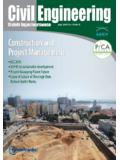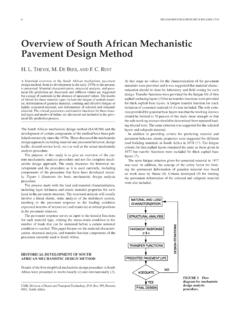Transcription of of the South African Institution of Civil Engineering ...
1 Of the South African Institution of Civil Engineering Volume 59 Number 1 March 20171coNteNtSJournal of the South African Institution of Civil Engineering Volume 59 Number 1 March 2017of the South African Institution of Civil EngineeringVolume 59 No 1 March 2017 ISSN 1021-2019 PublISherSouth African Institution of Civil EngineeringBlock 19, Thornhill Office Park, Bekker Street, Vorna Valley, Midrand, South AfricaPrivate Bag X200, Halfway House, 1685, South AfricaTel +27 (0)11 805 5947/48, Fax +27 (0)11 805 Gerhard HeymannUniversity of PretoriaTel +27 (0)12 420 edItor-IN-chIefProf Chris Clayton University of edItorVerelene de KokerTel +27 (0)11 805 5947, Cell +27 (0)83 378 edItorIAl PANelProf G Heymann University of PretoriaProf CRI Clayton University of SouthamptonProf Y Ballim University of the WitwatersrandProf W Burdzik University of PretoriaDr P Day Jones & Wagener (Pty)
2 LtdProf J du Plessis University of StellenboschProf GC Fanourakis University of JohannesburgProf M Gohnert University of the WitwatersrandProf PJ Gr be University of PretoriaDr C Herold Umfula Wempilo ConsultingProf A Ilemobade University of the WitwatersrandProf SW Jacobsz University of PretoriaProf EP Kearsley University of PretoriaProf C Roth University of PretoriaProf W Steyn University of PretoriaMr M van Dijk University of PretoriaProf JE van Zyl University of Cape TownProf C Venter University of PretoriaProf A Visser University of PretoriaDr E Vorster Aurecon South Africa (Pty)
3 LtdProf J Wium University of StellenboschProf A Zingoni University of Cape TownProf M Zuidgeest University of Cape TownPeer revIewINGThe Journal of the South African Institution of Civil Engineering is a peer-reviewed journal that is distributed internationallydeSIGN ANd reProductIoNMarketing Support Services, Ashlea Gardens, PretoriaPrINtINGF ishwicks, PretoriaPapers for consideration should be e-mailed to the Managing Editor at: South African Institution of Civil Engineering accepts no responsibility for any statement made or opinion expressed in this publication.
4 Consequently, nobody connected with the publication of this journal, in particular the proprietor, the publisher and the editors, will be liable for any loss or damage sustained by any reader as a result of his or her action upon any statement or opinion published in this journal. South African Institution of Civil Engineering 2 Vorticity filaments beneath regular turbulent flowR Mukaro DOI: 11 Planning for desalination in the context of the Western Cape water supply system C L Blersch, J A du Plessis DOI: 22 Numerical modelling of flexible pavement incorporating cross anisotropic material properties Part I: Surface circular loadingJ W Maina, F Kawana, K Matsui DOI: 28 Numerical modelling of flexible pavement incorporating cross anisotropic material properties Part II.
5 Surface rectangular loadingJ W Maina, F Kawana, K Matsui DOI: 35 Potential solution to pollution of groundwater by diffusion of volatile organic compounds through the primary HDPE geomembrane in composite lining systems of landfillsR A Pienaar, W Fourie DOI: 45 Updated provisions of SANS 10160 4 for steel structuresC P Roth, A Gebremeskel DOI: R. Vorticity filaments beneath regular turbulent flow. J. S. Afr. Inst. Civ. Eng. 2017:59(1), Art. #1445, 9 pages. PAPerJournal of the South African Institution of Civil engineeringISSN 1021-2019 Vol 59 No 1, March 2017, Pages 2 10, Paper 1445 DR RAPHAEL MUKARO is a senior lecturer in the Department of Physics and Electronics at North-West University, Mafikeng Campus, where he has worked since 2015.
6 From 2008 to 2014 he lectured Applied Physics at the University of KwaZulu-Natal (UKZN), where he taught third-year modules (mainly Electronics, Signal Processing Techniques and Measurement Systems). He was also a senior lecturer in physics at Bindura University of Science from 1999 to 2007. He received his PhD degree from UKZN in 2014. His current research interests are in the digital, statistical and wavelet study of turbulence generated by laboratory-plunging water waves. Contact details: North West University Mafikeng Campus School of Mathematical and Physical Sciences Department of Physics and Electronics Private Bag X2046 Mmabatho 2735 South Africa T: +27 18 389 2151 E: turbulent flow, velocity flow field, vorticity filament, instantaneous vorticity, mean vorticityINtroductIoNWave breaking is one of the most important problems for coastal engineers.
7 The breaking process leads to either surging, spilling or plunging breaker types. A plunging breaker is the most violent breaker, initiated when a steepening wave crest curls over to form an overturning jet. Steepening of the wave naturally induces high curvature and conse-quently strong vorticity. The jet plunges into the water ahead to form a plunger vortex, and also produces a splash-up leading to strong turbulence in the flow. The generated turbulence is a collection of weakly cor-related vortical motions, which, despite their intermittent and chaotic distribution over a wide range of space and time scales, actually consist of local characteristic eddy patterns that persist as they move around under the influences of their own and other eddies vorticity fields (Hunt & Vassilicos 2000).
8 Energy in the wave is transferred from the average flow to vortex structures at different scales. Due to the non-linear interactions between different scales, cascade processes of energy are very complex (Lin et al 2002). Wave-breaking turbulence accounts for most of the sediment suspension through the introduction of eddies associated with breaking waves, with increasing levels of tur-bulence coming towards the boundary layer from the water surface. Ocean and coastal engineers have been interested in wave loading generated by turbulence and extreme waves and their interaction with marine structures.
9 Ryu et al (2007) investigated potential damage to coastal structures caused by significant impacts of breaking waves and associated overtopping greenwater. The formation of bed topography, which, as a result of a complicated interaction between flow and sediment particles along the bed, has also received considerable attention. Lajeunesse et al (2010) used a high-speed video-imaging system to record the trajectories of the mov-ing particles over a flat bed, and observed that entrained particles exhibit intermittent motion, composed of the succession of periods of flight and rest.
10 Keshavarzi and Ball (2011) suggested that the structure of turbulent flow over the ripples in the bottom of an open channel is important for under-standing of sediment particle entrainment and its transport. Two important issues which they suggested need to be understood in sediment movement are the stochastic nature of instantaneous shear stresses over a ripple bed, and how it influences on sediment entrainment and transport. They employed an Acoustic Doppler Velocity Meter (Micro-ADV) with a sampling rate of 50 Hz to measure three-dimensional velocities, a charge-coupled device camera to record images of particle motion, and image-processing techniques to provide an accurate measurement of flow structure and particle entrainment from the bed.












